| المجموعات الإجتماعية |
| البحث |
| مشاركات اليوم |
 |
| هندسة وصيانة الطائرات Engineering & Aircraft Maintenance يختص بشرح منظومات الطائرة والرد على استفسارات مهندسي الطيران. راجع الفهرس من هنا |
| إضافة رد |
|
|
أدوات الموضوع |
 |
| هندسة وصيانة الطائرات Engineering & Aircraft Maintenance يختص بشرح منظومات الطائرة والرد على استفسارات مهندسي الطيران. راجع الفهرس من هنا |
| إضافة رد |
|
|
أدوات الموضوع |
| مشاركة [ 1 ] | ||||
|
||||
|
|
Why do most aircraft have only three landing gear
      Why not four          |
|||
|
|

|
| مشاركة [ 2 ] | ||||
|
||||
|
|
سؤال غريب فعلاً في إعتقادي بما أن الطائرة تستطيع الهبوط والإقلاع بثلاثة عجلات فيكفيها ذلك ..لأهمية الوزن لدنيا كذلك إنسيابية الطائرة الشكل الحالي للطائرات ذو فعالية عالية جداً ولاتنسى زيادة القطع في الطائرة يعني تكلفة أعلى وزيادة عدد القطع وزيادة في وقت الصيانة ولك مني كل تحية اخوك mechanic |
|||
|
|

|
| مشاركة [ 3 ] | ||||
|
||||
|
|
لم أسأل نفسي هذا السؤال لكن أظنه بسيط
ثلاث عجلات لتحقيق التوازن لنوعية هيكل الطائرة |
|||
|
|

|
| مشاركة [ 4 ] | ||||
|
||||
|
|
السلام عليكم
من المعروف في علم الطيران كتير ضروري عامل الوزن يعني اذا كان الوزن اخف فهو اكيد أفضل من ناحية استهلاك والوقود وكتير أشياء وما تنسى انه ال landig gear كبير مو صغير وكمان مكلف جدا ..وهاي بيزيد من تكلفة الصيانة ومثل ما قال الاخ ميكانك إنسيابية الطائرة الشكل الحالي للطائرات ذو فعالية عالية جداً |
|||
|
|

|
| مشاركة [ 5 ] | |||
|
|||
|
عضو خط الطيران
|
ثلاث عجلات لتحقيق التوازن لنوعية هيكل الطائرة
|
||
|
|

|
| مشاركة [ 6 ] | ||||
|
||||
|
|
الشكل الحالي يلبي جميع متطلبات الهبوط والاقلاع اضافة للاسباب التالية : 1 . ان وزن الطائرة يتركز في منطقة العجلات الرئيسية ( main weels ) بسبب وجود معطم الاجهزة والحمولات وخزانات الوقود في هذه المنطقة في اغلب الطائرات ولا توجد مثل هذه الاوزان الكبيرة في منطقة العجلة الامامية ( nose weel ) مما لا يستدعي استخدام عجلة رابعة في الامام . 2 . ان عملية الاقلاع والهبوط تتم بالاستناد الى العجلات الرئيسية ( main weels ) ولا تتحمل العجلة الامامية اية ضغط ناتج عن عملية الاقلاع والهبوط مما لايستدعي استخدام عجلة رابعة في الامام 3 . العجلة الامامية الواحدة تعطي الطائرة مرونة دوران عالية اثناء الدرج والسحب والارجاع الى الخلف 4 . للاسباب الواردة اعلاه فان اضافة عجلة رابعة بدون الحاجة لها يؤدي الى اضافة اوزان اضافية غير مبررة يمكن الاستفادة منها في الطائرة لاغراض اخرى اضافة الى الكلفة غير المبررة تقبل خالص تحياتي اخي العزيز طارق
اخوك عماد المشهداني |
|||
|
|

|
| مشاركة [ 7 ] | ||||
|
||||
|
|
طبعا ذلك سيكون اولا واخرا بسبب هيل الطائرة الانسيابي
ولو فرضنا ان لها اربع عجلات فإن ذلك سوف يؤثر على الطائرة عند TAKE OFF وسيعيق اداء الطائرة وتتغير زاوية الاقلاع |
|||
|
|

|
| مشاركة [ 8 ] | ||||
|
||||
|
|
اي والله سؤآل غريب ...وفعلاً ليش مو اربعه او اكثر ...اشكراً لجميع الاخوان على ردودهم...ومشكور اخوي على الموضوع الحلو...
|
|||
|
|

|
| مشاركة [ 9 ] | ||||
|
||||
|
|
Most aircraft today have three landing gear. Two main landing gear struts located near the middle of the aircraft usually support about 90% of the plane's weight while a smaller nose strut supports the rest. This layout is most often referred to as the "tricycle" landing gear arrangement. However, there are numerous other designs that have also been used over the years, and each has its own advantages and disadvantages. Let's take a closer look at the various undercarriage options available to engineers. Tailwheel or Taildragger Gear Though the tricycle arrangement may be most popular today, that was not always the case. The tailwheel undercarriage dominated aircraft design for the first four decades of flight and is still widely used on many small piston-engine planes. The taildragger arrangement consists of two main gear units located near the center of gravity (CG) that support the majority of the plane's weight. A much smaller support is also located at the rear of the fuselage such that the plane appears to drag its tail, hence the name. This tail unit is usually a very small wheel but could even be a skid on a very simple design. 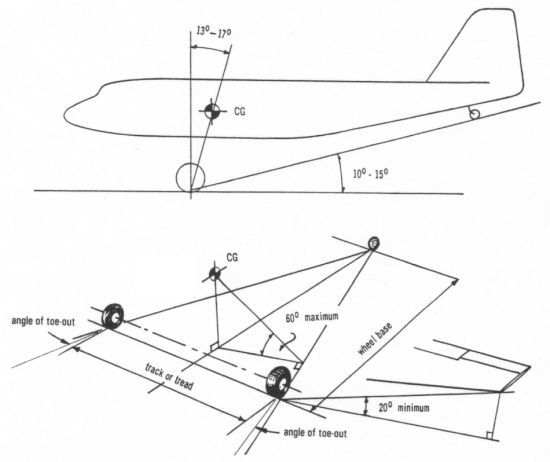 Taildragger or tailwheel landing gear What makes this form of landing gear most attractive is its simplicity. The gear are usually relatively lightweight, and the two main gear can also be easily encased in streamlined fairings to produce low drag in flight. Another potential advantage results from the fact that the plane is already tilted to a large angle of attack as it rolls down the runway. This attitude helps to generate greater lift and reduce the distance needed for takeoff or landing. This attitude is also an advantage on propeller-driven planes since it provides a large clearance between the propeller tips and the ground. Furthermore, taildragger planes are generally easier for ground personnel to maneuver around in confined spaces like a hangar. However, the greatest liability of this landing gear layout is its handling characteristics. This design is inherently unstable because the plane's center of gravity is located behind the two main gear. If the plane is landing and one wheel touches down first, the plane has a tendency to veer off in the direction of that wheel. This behavior can cause the aircraft to turn in an increasingly tighter "ground loop" that may eventually result in scraping a wingtip on the ground, collapsing the gear, or veering off the runway. Landing a taildragger can be difficult since the pilot must line up his approach very carefully while making constant rudder adjustments to keep the plane on a straight path until it comes to a stop. Many taildragger designs alleviate these handling problems by fitting a tailwheel that can be locked instead of swiveling on a castor. Locking the tailwheel helps keep the plane rolling in a straight line during landing. 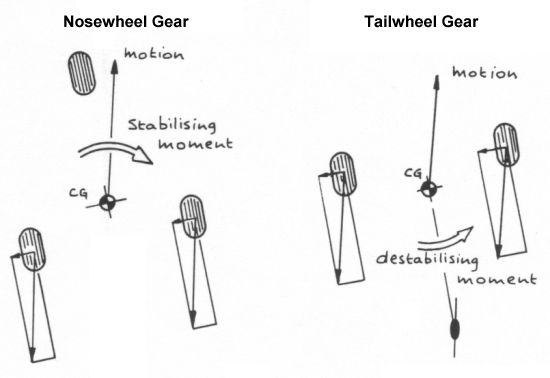 Stable and unstable behavior of tricycle gear vs. taildragger gear Another disadvantage of the taildragger is poor pilot visibility during taxiing since he is forced to peer over a nose that is tilted upward at a steep angle. It is also often difficult to load or unload heavy cargos because of the steep slope of the cabin floor. Similarly, pilots and passengers are forced to walk uphill during boarding and downhill after arrival. Many aircraft also rely on gravity to bring fuel from tanks to the engine, and some planes have been known to have difficulty starting the engine because it is uphill from the fuel supply. 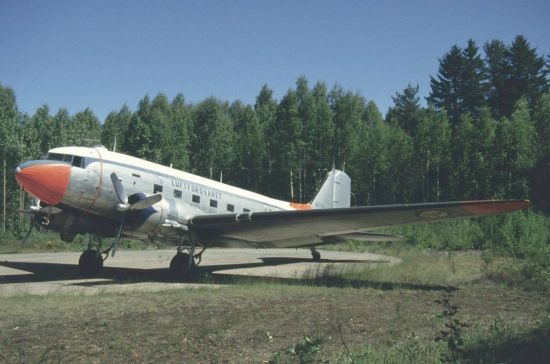 DC-3 Dakota airliner illustrating its taildragger landing gear Good examples of taildragger aircraft include the Spitfire and DC-3 of World War II. Tricycle or Nosewheel Gear Now the most popular landing gear arrangement, the tricycle undercarriage includes two main gear just aft of the center of gravity and a smaller auxiliary gear near the nose. The main advantage of this layout is that it eliminates the ground loop problem of the taildragger. This arrangement is instead a stable design because of the location of the main gear with respect to the center of gravity. As a result, a pilot has more latitude to land safely even when he is not aligned with the runway. 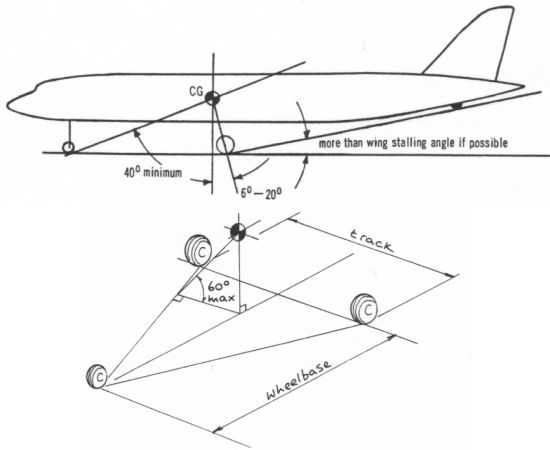 Tricycle or nosewheel landing gear Furthermore, the tricycle arrangement is generally less demanding on the pilot and is easier to taxi and steer. The tricycle gear also offers much better visibility over the nose as well as a level cabin floor to ease passenger traffic and cargo handling. A further plus is that the aircraft is at a small angle of attack so that the thrust of the engine is more parallel to the direction of travel, allowing faster acceleration during takeoff. In addition, the nosewheel makes it impossible for the plane to tip over on its nose during landing, as can sometimes happen on taildraggers. The greatest drawback to tricycle gear is the greater weight and drag incurred by adding the large nosewheel strut. Whereas many taildraggers can afford to use non-retracting gear with minimal impact on performance, planes with nosewheels almost always require retraction mechanisms to reduce drag. Some planes with tricycle gear also have difficulty rotating the nose up during takeoff because the main wheels are located so close to the elevator, and there may be insufficient control effectiveness. Similarly, the closeness to the rudder reduces its effectiveness in counteracting crosswinds. Another critical factor when designing tricycle gear is to properly balance the load carried by the main gear versus the nosewheel. Too little load on the main wheels reduces their braking effectiveness while too little on the nosewheel reduces its steering effectiveness. Careful balancing of weight is also important to prevent the plane from tipping back on its tail while at rest on the ground. 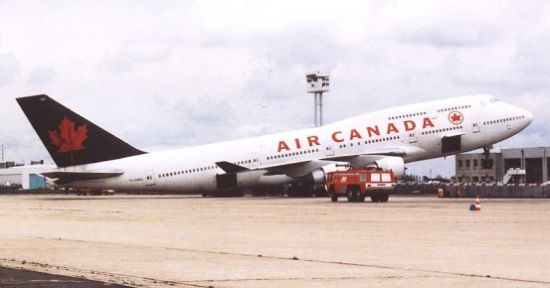 Danger of tail sitting exemplifided by an improperly loaded 747 There are many examples of aircraft with tricycle landing gear, including the F-16 and Cessna 172. Bicycle Gear A relatively uncommon landing gear option is the bicycle undercarriage. Bicycle gear features two main gear along the centerline of the aircraft, one forward and one aft of the center of gravity. Preventing the plane from tilting over sideways are two small outrigger gear mounted along the wing.  Bicycle landing gear The only real advantage of bicycle gear is lower weight and drag than either the taildragger or tricycle arrangements. Bicycle gear are also useful on planes with very long and slender fuselages where there is little room for more traditional undercarriage arrangements. Unfortunately, bicycle gear are very demanding on the pilot who must maintain a very level attitude during takeoff and landing while carefully managing airspeed. The pilot must also compensate for any rolling motion that could cause the plane to land unevenly on one of the outrigger gear, and crosswinds are particularly difficult to deal with. 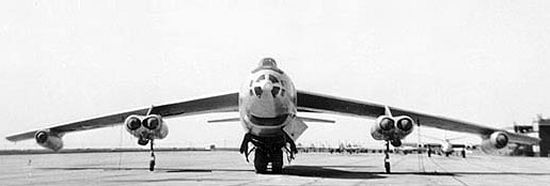 Bicycle landing gear of the B-47 Stratojet Because of these limitations, bicycle gear are generally limited to planes with high aspect ratio wings that generate high lift at low angles of attack. Good examples of such planes are large bombers with a narrow fuselage and large wingspan like the B-47. Another common application of the bicycle undercarriage is aboard vertical takeoff and landing designs like the Harrier. Here, the gear layout provides safety and stability in case of an engine failure during landing. Single Main Gear A special subcategory of the bicycle undercarriage is the single gear. This layout features a single large gear unit and a much smaller auxiliary tailwheel along the centerline. Outriggers are again provided for stability.  Single main landing gear This design is particularly simple, lightweight, and low drag and may even include skids rather than wheels. This simplicity makes the gear arrangement attractive for use on light planes like gliders and sailplanes, but the single main gear is generally impractical for larger aircraft.  U-2 Dragon Lady and its landing gear arrangement Perhaps the best known application of a single main gear arrangement is the U-2 reconnaissance plane. This aircraft has a single large gear unit near the center of gravity plus a much smaller tailwheel. Two additional outriggers called "pogos" are attached by ground crew to keep the plane from tipping during taxi, but these are removed prior to takeoff. Quadricycle Gear Quadricycle gear are also very similar to the bicycle arrangement except there are four main gear roughly equal in size and mounted along the fuselage. 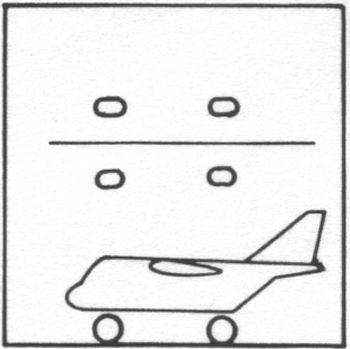 Quadricycle landing gear Like bicycle gear, the quadricycle undercarriage also requires a very flat attitude during takeoff and landing. This arrangement is also very sensitive to roll, crosswinds, and proper alignment with the runway. The most significant advantage of quadricycle gear is that the plane's floor can be very close to the ground for easier loading and unloading of cargo. However, this benefit comes at the price of much higher weight and drag than bicycle gear. 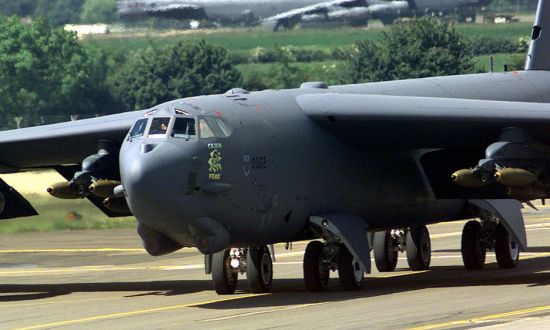 Quadricycle landing gear of the B-52 Stratofortress Quadricycle gear are sometimes used on cargo planes, but probably the most well known example is the B-52 bomber. This aircraft employs a cross between the quadricycle and bicycle arrangements since it has four main gear plus two small outriggers near the wingtips. Multi-Bogey Gear A final variation that is worth mentioning is the use of multiple wheels per landing gear strut. It is especially common to place two wheels on the nose strut of the tricycle arrangment to provide safety and steering control in case of a tire blowout. This additional tire is particularly useful on carrier-based aircraft where two nosewheels are a requirement. Multiple wheels are also often used on main gear units for added safety, especially on commercial airliners.  Multi-bogey landing gear When multiple wheels are placed on the same gear unit, they are attached together on a structural device called a bogey. The heavier the aircraft becomes, the more wheels are typically added to the bogey to spread the plane's weight more evenly across the runway pavement. In general, a plane weighing less than 50,000 lb (22,680 kg) has only one wheel per main gear strut. Aircraft weighing up to 200,000 lb (90,720 kg) usually carry two wheels per strut. On planes weighing up to 400,000 lb (181,440 kg), a four-wheel bogey is typical. Aircraft of greater weight often carry four bogeys, each with four to six wheels. 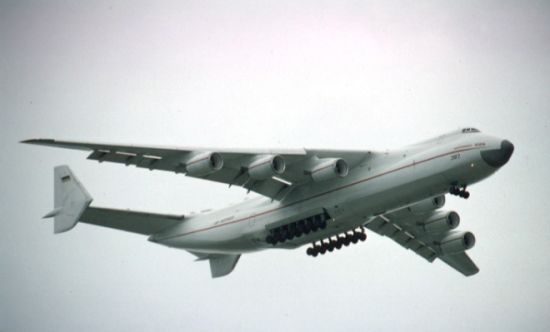 The many, many, many landing gear wheels of the An-225 The best examples of multi-bogey aircraft are large mega jets like the An-225. This mammoth cargo plane has seven pairs of wheels on each main gear assembly plus four nosewheels, combining for a total of 32 tires! Another good example is the Boeing 747. The 747 is equipped with four main gear units, each with four-wheel bogies, plus twin nosewheels so that the plane's weight is spread across 18 wheels. Summary Landing gear serves three primary purposes--to provide a support for the plane when at rest on the ground, to provide a stable chassis for taxiing or rolling during takeoff and landing, and to provide a shock absorbing system during landing. Regardless, all of these tasks are secondary to the plane's primary role as an efficient mode of travel through the air. To aircraft designers, landing gear are nothing more than a necessary evil since planes are designed primarily for their performance in flight rather than on the ground. There have even been attempts over the years to eliminate landing gear entirely. The most extreme case was a study done by the Royal Navy to see if a jet plane could make a belly landing on the deck of an aircraft carrier coated with a rubberized surface. If successful, the method would eliminate the need for the very strong and heavy landing gear used on carrier-based aircraft. Unfortunately, the method proved impractical, but it shows the lengths some will go to while attempting to eliminate the need for landing gear! We have seen that landing gear come in many varieties and each option has its own advantages and disadvantages. Selecting the best arrangement for a given aircraft is a trade-off between these strengths and weaknesses as they apply to the environment the plane is designed for. As a result, designers try to select the simplest, smallest, lightest, and least expensive solution possible to do the job while maintaining safety. That is why most planes only have three landing gear rather than four because fewer gear weigh less, require less structure aboard the plane, take up less space when retracted, and generate less drag |
|||
|
|

|
| مشاركة [ 10 ] | ||||
|
||||
|
|
بما انه الطيارة شغالةتمام ب 3 عجال لشو الرابع؟؟ زودنا بالتفسير العلمي لو سمحت.
|
|||
|
|

|
| مشاركة [ 11 ] | ||||
|
||||
|
|
الـ A340 فيها 4
واحد في الـ Nose واحد في الجناح الأيمن وواحد في الأيسر وواحد بينهم (في الوسط) |
|||
|
|

|
| مشاركة [ 12 ] | ||||
|
||||
|
|
الشغله تتعلق بطريقه نزول الطائرة والذي يجب ان تكون بمرحلتين الاولى ان تتم على عجلات رئيسيه وبعدين ننزل الموجهه(والتي ممكن تكون اماميه انفيه وممكن ان تكون خلفيه ذنبيه)
هناك انواع من الطائرات لها اكثر من ثلاث مثل الهرير والبوينك 747 واليو 2 والكثير من الانواع وحسب طريقه نزولها وثقلها وغيره من الاسباب ولكن السبب الرئيسي هو انو الطائرة تنزل بمرحلتين كما شرحنا سابقا(مو تنزل مرة وحده وتنطب على الارض مثل الحجر) |
|||
|
|

|
| إضافة رد |
 هندسة وصيانة الطائرات Engineering & Aircraft Maintenance
هندسة وصيانة الطائرات Engineering & Aircraft Maintenance
|
|
|
|
|
|
 المواضيع المتشابهه
المواضيع المتشابهه
|
||||
| الموضوع | المنتدى | |||
| اعرف نفسك من الحرف الاول من اسمك | القسم العام | |||
| هل سألت نفسك يوما هذا السؤال ؟ | القسم العام | |||
| موسوعه صحابه الرسول صلي الله عليه وسلم | الملتقى الإســلامـي | |||
| شهر محرم ويوم عاشوراء ... | الملتقى الإســلامـي | |||